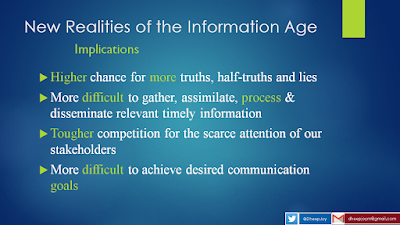As a fast-aging yet hopefully youthful practitioner of Government communication in the world's largest democracy, I have been a rather curious observer and passionate student of the fast-changing media and communication scenario in India, as well as in the world at large. This humble inquiry has so far yielded many more questions than answers. Nevertheless, I take the opportunity afforded by the online medium to share some learnings, observations and insights. It is my hope that some of them turns out to be of some value to you too.
In this post, I would like to reflect specifically on the transformed context in which Government communication has to operate in India today.
The Communication Context Today
The
communication domain has been witnessing nothing short of a revolution
recently. The public sphere has undergone a multidimensional transformation.
New Realities of the Information Age: Transformational Forces
A confluence of various
forces has pedalled this transformation.
New Realities of the Information Age: Trends
The new
information age is thus characterized by the following trends:
- Exponential increase in volume, velocity and variety of data and information
- Every ‘connected’ person is now a public broadcaster
- News breaks – and dies - 24/7/365
- Yet, often, it is not news that breaks; thanks to the almost pervasive editorialization of news
- Communicators are trying to cut down on ‘middlemen’; there is an increasing disintermediation of communication, facilitated by social media
- Overabundance of information, leading to a scarcity of attention among the consumers of information; yes, we live in an attention economy (concept propounded by Herbert Simon)
- Increasing acceleration of change & uncertainty in the media & communication sector
The
democratization of communication has made fundamental
shifts in the size, scope and nature of both the supply and demand for
communication from organizations of all types, especially Government
organizations; further, both supply and demand for such communication
will only continue to increase in future. This has given the
communication function a pre-eminent place in the larger domain of governance –
the governance of any organization in general, and that of the nation in
particular.
New Realities of the Information Age: Implications
This shift leads
to the following implications:
New Realities of the Information Age: Imperatives
In this
scenario, organizational and Government communication has to confront and
embrace the following new imperatives:
Note: In case you are hearing it for the first time, it is not who I say that "If
content is king, context is God". Click here to find out who said it, and what he means by it.
Let me close with this for now. Hope the context of Government communication articulated above presents one more (brief and admittedly incomplete) perspective on the challenges and opportunities this field offers, and potentially gives enough room for excitement, learning and joy for the passionate and aspiring practitioner, observer and student of the Indian media and communication industry.
Thank you very much for your kind attention.
- Dheep Joy Mampilly IIS, @DheepJoy, dheepjoym@gmail.com
(The above content has been excerpted from the introductory part of a presentation I gave on behalf of my team, in July 2015, to senior officers and regional unit heads of our organization, on the immense potential of regional social media in India)






